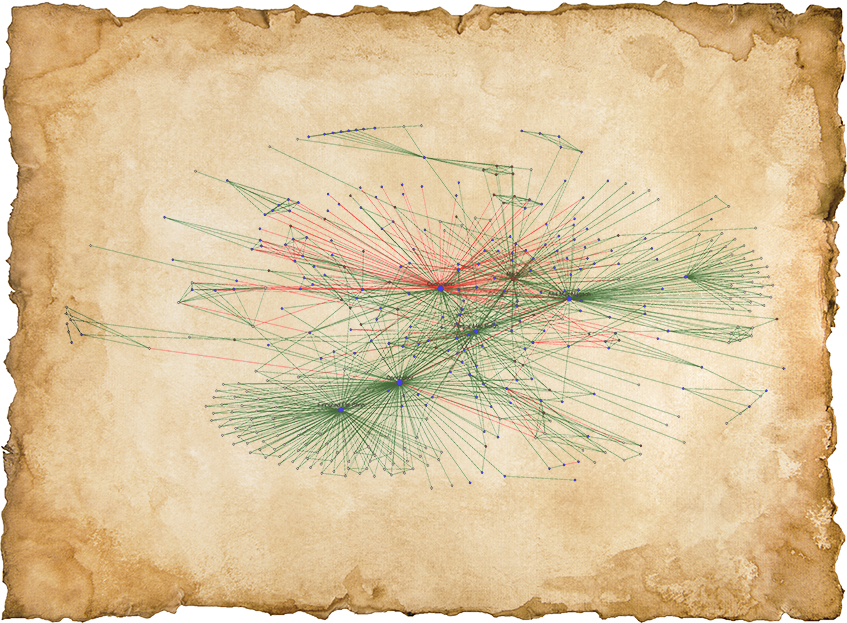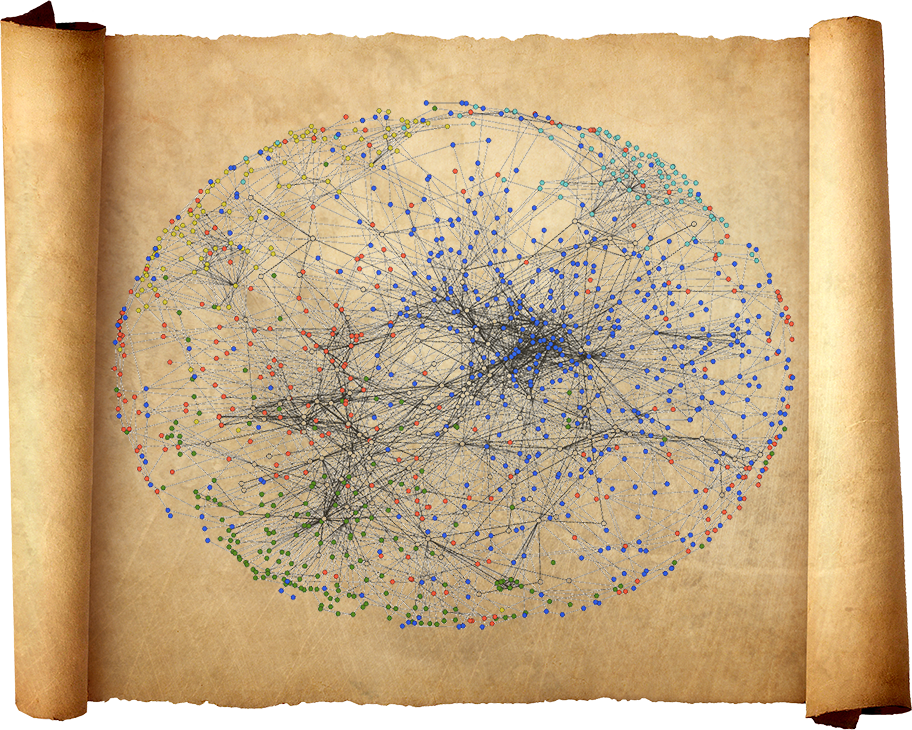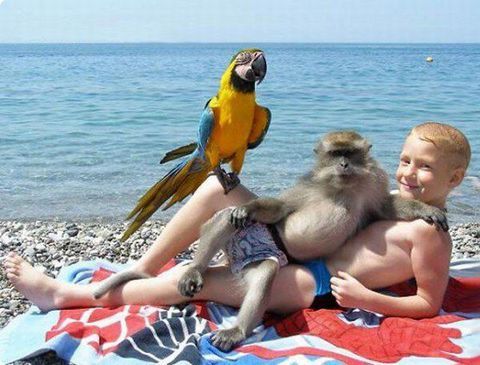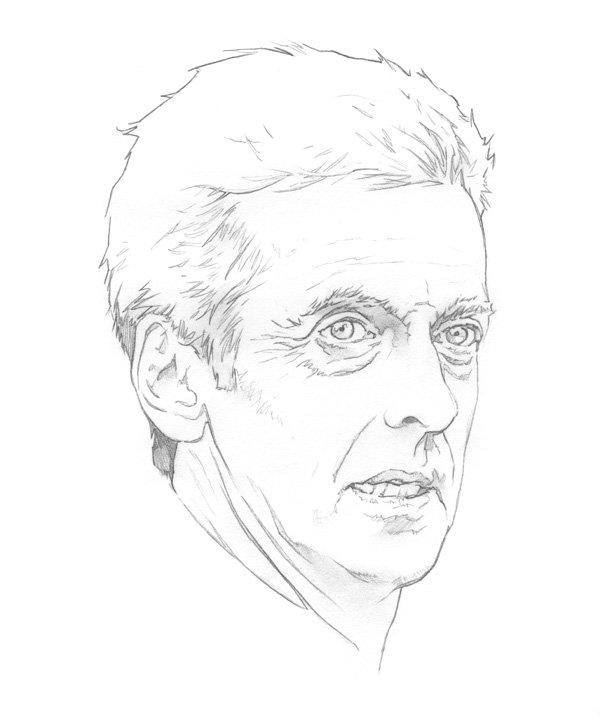The story of how Kenna and Mac Carron got here begins with the Irish tale of the cattle-raid of Cooley, or the Táin Bó Cúailnge. That yarn tells how the warrior-queen Medb of Connacht rallies an army to steal a fine bull from Ulster, and how youthful Cúchulainn, an Ulster folk hero, stands against her. Complete with a maiden prophet with three pupils in each eye, wild chariot rides, and an enormous cast of characters, it's a story to grip anyone's imagination.
It's a story that Kenna and Mac Carron, who are both Irish, have known since childhood. Several years ago, Kenna, who has a successful career as a physicist, found his thoughts returning to mythology. It wasn’t as big a departure as it might seem at first. "In statistical physics, you're dealing with objects such as gasses that are comprised of molecules and atoms," he says. "The system consists of many small entities, and so many of them you cannot deal with them individually, you have to deal with them statistically." Some physicists have started to use similar methods to look at how large numbers of people interact to produce aspects of human society, and Kenna wondered whether they could be applied to myths and stories. The Táin, which comes to us in pieces from many different manuscripts, the oldest nearly 1,000 years old, is considered literature rather than historical account. But it might still encode, in a way statistics can reveal, information about the society that produced it. Math might also help classify tales in a new way, quantitatively, in addition to the usual qualitative classifications.
In thinking these thoughts, he had plenty of company — the idea that computation might be able to provide insight into literature and history has gathered speed in the last couple of decades. But it has provoked some controversy, as researchers try to figure out how computer science and statistics can be helpful in fields where trained reading and intuition are central. There are many levels of the debate, but it usually circles around to this point: Can you answer valuable questions this way? Can these tools provide information that is hard to grasp otherwise?
Math might help classify tales in a new way: quantitatively
It's easy, it turns out, to do this badly. Siccing a pattern-finding program on a novel might uncover meaningless patterns, or ones so obvious that a high school freshman could see them. But Tim Tangherlini, a folklorist and professor at UCLA who hosted a 2010 National Endowment for the Humanities meeting on network analysis, sees potential. "There are a lot of latent patterns in this material that you can't discern overtly. You can do it very well as a trained reader — by developing ways of thinking about the material that let us see latent patterns — but we have a very hard time articulating it." Algorithms could help make those patterns visible. In the case of social networks, they can reveal which people are the most connected or powerful, as well as how densely connected the network is and the average distance between any two people, qualities that vary depending on the type of group.
For instance, research suggests that real social networks have different properties than fictional ones. The idea of seeing where epics — which are certainly not all fact, but perhaps not all fiction — fell on that spectrum appealed to Kenna, who brought Mac Carron on to work on the project. In 2010, with funding from the Leverhulme Trust, Mac Carron went through the Táin, Beowulf, and The Iliad, noting each time a character appeared and each time he or she interacted with someone. Eventually he had a map of the social networks in each story that he could compare against information about real-world networks that other researchers had built of groups like scientists, jazz musicians, and film actors.
Perhaps the 'Táin' is not as fantastical as its reputation would suggest
What Kenna and Mac Carron found was that the epics fell between the real networks and the fictional ones. The network in The Iliad is relatively realistic, and Beowulf's also has realistic aspects, with the exception of the connections to Beowulf himself. That chimed with the idea from the humanities that he, unlike some others in the story, may not have existed. The Táin's network was more artificial. Interestingly, however, they found that a lot of the Táin's unreality was concentrated in just a few, grotesquely over-connected characters. When they theorized that some of those characters might actually be amalgams — for instance, that some of the times the queen of Connacht is said to speak to someone, it might be a messenger speaking for her instead — the network began to look more realistic. At least from a social network perspective, perhaps the Táin is not as fantastical as its reputation would suggest, the researchers proposed. That doesn't mean the events really happened, or that the people are real. But it raises the question of why the network looks the way it does.

The Táin network. Green lines represent friendly relations and red lines represent unfriendly ones. The upper node with red connections is Cúchulainn. The neighboring node to the right is the warrior-queen Medb.
Intrigued by the results of their first analysis, Kenna and Mac Carron turned to the Icelandic sagas next. There are few texts more perfectly suited to social network analysis. The sagas overflow with characters large and small whose love affairs, blood feuds, and family ties play out against the backdrop of the Scandinavian settlement of Iceland in the 10th and 11th centuries. What parts of the yarns might have really happened, and which people really existed, are longstanding objects of fascination among scholars of Old Norse.
The pair uncovered a few interesting strands from looking at the social networks. For one thing, the saga networks are quite realistic, more so than those of the three epics they'd analyzed before. They also found "a large overlap in the social network of Njal's Saga and the Laxdæla Saga. We didn't really know why that was there," says Mac Carron. And they noticed that the Laxdæla Saga has an unusually high number of interactions involving women.
They had unwittingly stumbled onto patterns that tied into theories humanities scholars had been discussing for years. The sagas are thought to have been written using actual genealogical information, says Tangherlini — in fact, many of the Icelandic sagas are classified as "family sagas," and they may have been written to cement a family's glorious past — so it makes sense that their social networks are very realistic. There's a theory that the person who wrote Njal's Saga used Laxdæla as a source, an idea that recognizes the interconnectedness of the locations and people involved. And Laxdæla, which tells the story of Guðrún Ósvífrsdóttir and her four marriages, is thought by some scholars and critics to have been written by a woman. The physicists' networks suggest that the patterns close readers were picking up on are quantifiable. They’d arrived at similar observations using different methods.
"There are a lot of latent patterns in this material that you can’t discern overtly."
It doesn't prove the theories are correct. Network analysis will never be able to tell us which people wrote the stories, or which events really happened. "But it's valuable to have those suspicions quantified by this research," says Tom Birkett, the lecturer in Old English at University College Cork.
The next question is whether such analysis can reveal things that scholars haven’t noticed before. Tangherlini and Birkett say yes. Tangherlini found with network analysis that contrary to received wisdom, the Norse system of fostering, where the son of one family is sent to be raised by another, actually doesn't prevent conflict, at least as depicted in the sagas. Fostering actually leads to more hostile interactions in the stories. "We can discover patterns that perhaps weren't noticed before," he says. "And we can see how they play a role in the overarching complexity of character interactions."
"That’s a classic research question. Why tell this story the way you’re telling it, at the time you’re telling it?"
Birkett is most intrigued by the fact that Mac Carron and Kenna's analysis reveals that some of the people at the center of the saga's social networks are not the heroes of the stories, the people that literary critics tend to focus most on. Hidden in the wallpaper, so to speak, are individuals who are very well-connected, who might have a vast web of influence. These people, often chieftains, are important people in the saga societies, and may be patrons of the tale-tellers. "We could tell you this minor character appears in five different sagas. But what Ralph and Padraig could tell you is how many connections they make and how extensive their network is," says Birkett. "It might make us think just who these sagas were written for, and just how important these people in the back might be."
Since Mac Carron and Kenna published their first paper two years ago, they've sought out collaborators in the humanities, in part through a meeting called Math Meets Myths, which they're holding this September for the second time and which Birkett and Tangherlini have attended. Mac Carron says, "Our tagline was almost: "We can give you answers, but we don't know the questions."

Network combining the five major Icelandic sagas. White nodes represent characters who appear in more than one saga. There is a large overlap of characters from Laxdæla Saga (green) and Njáls Saga (red). The other sagas are Egil (blue), Vatnsdaela (yellow), and Gisla (light blue).
Quantitative analysis of literature is still an emerging field, and not everyone thinks it’s a good use of time and resources. But the example of Kenna and Mac Carron’s work suggests that done right, it can provide new inspiration for humanities scholars. Birkett can immediately fire off three ways social network analysis alone could help explore the Icelandic sagas. It could help establish the order in which they were written, thanks to overlap between characters and locations. It could help scholars sort the Norse sagas, of which the Icelandic sagas are just a part, into subgenres. And by providing a new way to compare sagas of different vintages, it could suggest the extent to which the writers of the Icelandic sagas, who lived hundreds of years after the events supposedly happened, are depicting a society like theirs rather than that of their ancestors.
what makes a good story, and how has our understanding of that changed over time?
At a broader level, comparing social networks in these old stories to those in more recent fiction may help reveal deeper truths about what literature has meant to people through the ages. "Great literature might have been more representative of society in the past," says Birkett. "There's a big difference between a realistic representation of social networks and a realistic representation of life, or the human condition ... I don't think you could write a modern novel that accurately represented social groups [the way the sagas do], because there would be too many characters." Mac Carron echoes that sentiment. "Njal's Saga has something like an average of four new characters every page," he says. "Whereas in modern fiction, I think they do try to make sure you can keep track of everyone, with the exception of maybe Game of Thrones." Even in Harry Potter and Lord of the Rings — which Mac Carron and Kenna analyzed to compare with the sagas — the networks are nowhere near as vast. That density of characters, and the realism of their networks, suggest a different purpose for literature than might be the case now — the creation of portraits of societies, rather than portraits of individuals.
These are big, complex questions: what makes a good story, and how has our understanding of that changed over time? They are questions Mac Carron and Kenna admit are outside their purview. But for Tangherlini and his colleagues in the humanities, they’re some of the key questions out there, and ones that network analysis, by contributing fresh information and new perspectives, can make a valuable contribution to answering.
"That's a classic research question. Why tell this story the way you're telling it, at the time you're telling it?" Tangherlini says. "That's the humanities, right there."
Lead image: De Agostini / G. Dagli Orti / Getty Images
Parchment backgrounds from Shutterstock (1, 2, 3)






 Ken Moss, founder of the program that became Microsoft's Bing service, is now Chief Technology Officer at EA. As CTO, Moss is in charge of EA's Digital Platform and Information Technology divisions.
"Ken joins us at an important time in EA's...
Ken Moss, founder of the program that became Microsoft's Bing service, is now Chief Technology Officer at EA. As CTO, Moss is in charge of EA's Digital Platform and Information Technology divisions.
"Ken joins us at an important time in EA's...



















